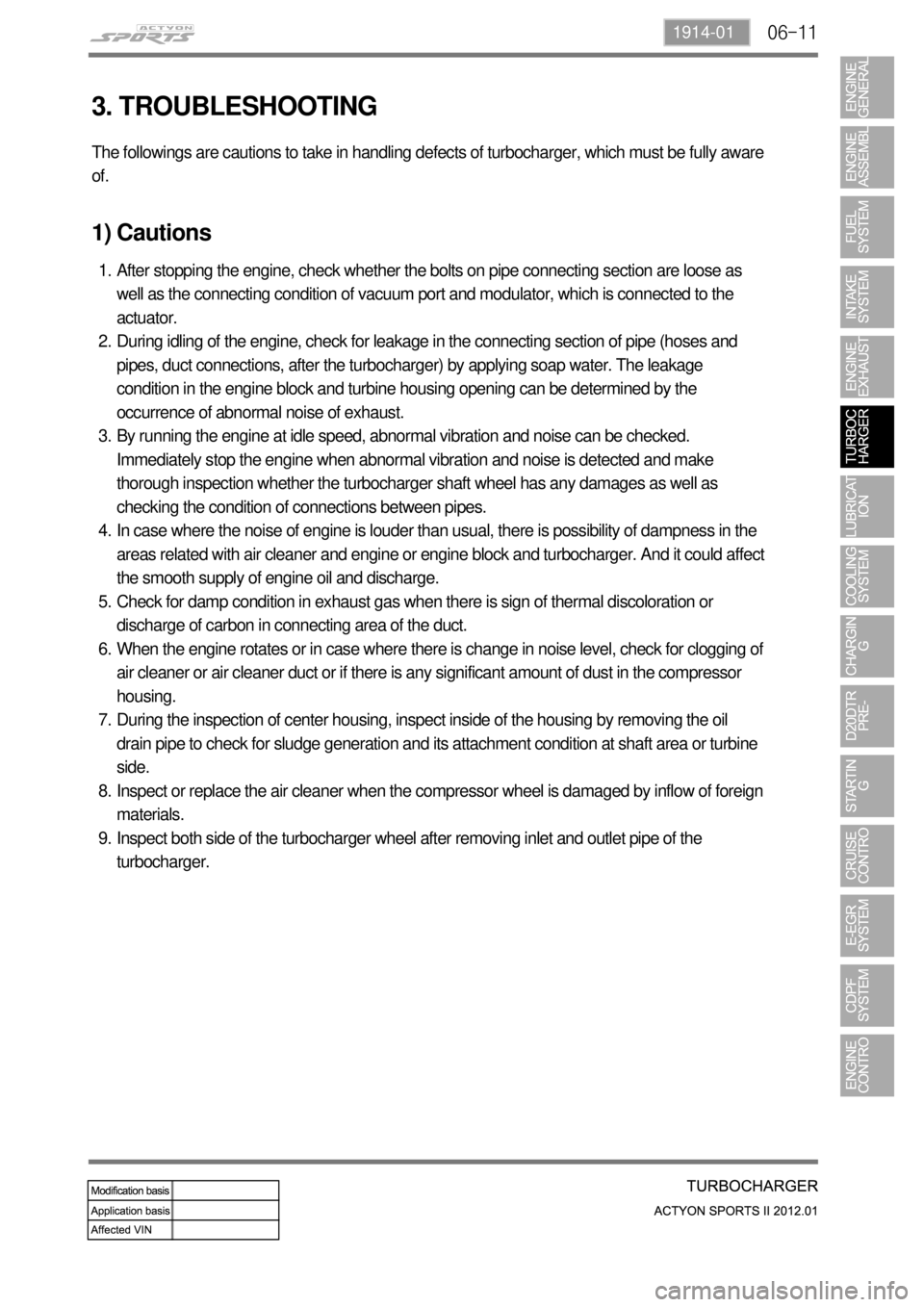Page 212 of 828
04-51719-00
3) Troubleshooting Sequence
The basic checks for intake system are as follows:
Basic Checks for Intake System ▶
Make sure to replace or clean the air
cleaner element periodically. Otherwise,
engine will be derated or work abnormally
because of low intake air volume.
Unlike the fuel system, which is a closed
circuit, the intake system is an open circuit
system. Therefore any malfunction may
occur due to dust and dirt.
Most of the connections consist of hoses
so the system cannot withstand high
temperature and pressure. Also it can be
deformed or loosened easily because it is a
clamp mounting system. Thus, when
checking the engine, basic inspections,
such as tightened status check and visual
inspection for hose, etc., should be carried
out in advance.
Other Checks for Intake System ▶
If the intake system is free of any faults,
check for EGR and PCV oil separator.
Page 224 of 828

06-4
2. INSPECTION
1) Cautions During Driving
The following lists cautions to take during test drive and on the turbocharger vehicle, which must
be considered during the operation.
It's important not to drastically increase the engine rpm starting the engine. It could make
rotation at excessive speed even before the journal bearing is lubricated and when the
turbocharger rotates in poor oil supply condition, it could cause damage of bearing seizure
within few seconds.
If the engine is running radically after replacing the engine oil or oil filter brings poor oil supply
condition. To avoid this, it's necessary to start off after idling the engine for about 1 minute
allowing oil to circulate to the turbocharger after the replacement.
When the engine is stopped abruptly after driving at high speed, the turbocharger continues to
rotate in condition where the oil pressure is at '0'. In such condition, an oil film between the
journal bearing and the housing shaft journal section gets broken and this causes abrasion of
the journal bearing due to the rapid contact. The repeat of such condition significantly reduces
life of the turbocharger. Therefore, the engine should be stopped possibly in the idle condition. 1.
2.
3.
After string for long period of time during winter season or in the low temperature condition
where the fluidity of engine oil declines, the engine, before being started, should be cranked to
circulate oil and must drive after checking the oil pressure is in normal condition by idling the
engine for few minutes.
Page 231 of 828

06-111914-01
3. TROUBLESHOOTING
The followings are cautions to take in handling defects of turbocharger, which must be fully aware
of.
1) Cautions
After stopping the engine, check whether the bolts on pipe connecting section are loose as
well as the connecting condition of vacuum port and modulator, which is connected to the
actuator.
During idling of the engine, check for leakage in the connecting section of pipe (hoses and
pipes, duct connections, after the turbocharger) by applying soap water. The leakage
condition in the engine block and turbine housing opening can be determined by the
occurrence of abnormal noise of exhaust.
By running the engine at idle speed, abnormal vibration and noise can be checked.
Immediately stop the engine when abnormal vibration and noise is detected and make
thorough inspection whether the turbocharger shaft wheel has any damages as well as
checking the condition of connections between pipes.
In case where the noise of engine is louder than usual, there is possibility of dampness in the
areas related with air cleaner and engine or engine block and turbocharger. And it could affect
the smooth supply of engine oil and discharge.
Check for damp condition in exhaust gas when there is sign of thermal discoloration or
discharge of carbon in connecting area of the duct.
When the engine rotates or in case where there is change in noise level, check for clogging of
air cleaner or air cleaner duct or if there is any significant amount of dust in the compressor
housing.
During the inspection of center housing, inspect inside of the housing by removing the oil
drain pipe to check for sludge generation and its attachment condition at shaft area or turbine
side.
Inspect or replace the air cleaner when the compressor wheel is damaged by inflow of foreign
materials.
Inspect both side of the turbocharger wheel after removing inlet and outlet pipe of the
turbocharger. 1.
2.
3.
4.
5.
6.
7.
8.
9.
Page 739 of 828
12-134610-01
Oil Pump Pressure Check ▶
Unscrew the pressure line fitting in power
steering pump.
Install the pressure gauge between the
power steering pump and the power
steering oil pressure line.
Place the shift lever to neutral position.
Apply the parking brake.
Open the valve in pressure gauge. Start
the engine and let it run at idle speed.
Turn the steering wheel several times so
that the oil temperature reaches to normal
operating level. 1.
2.
3.
4.
5.
Before checking the pressure, check the oil
level and belt tension. Prepare the empty
container to collect the spilled oil during the
service. Check the oil pump pressure to locate any
defect in oil pump.
Fully close the valve in pressure gauge and
measure the oil pressure. 6.
Relief pressure
90 ± 3 bar
Oil pump
Steering gear box
To prevent internal damage, do not close
the gauge valve over 10 seconds.
Keep the oil temperature at proper range. -
-